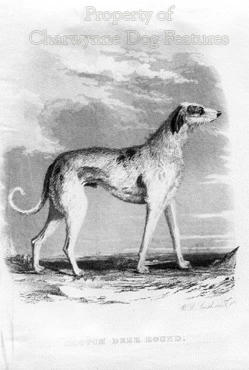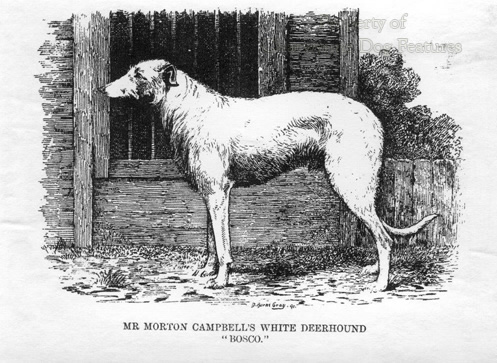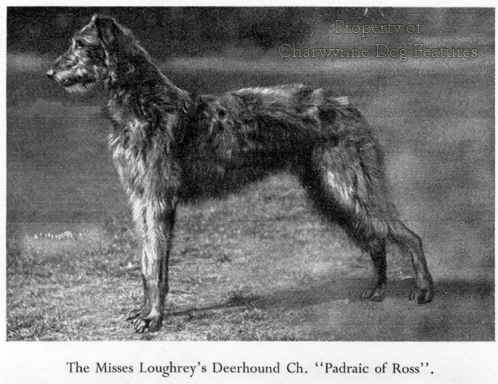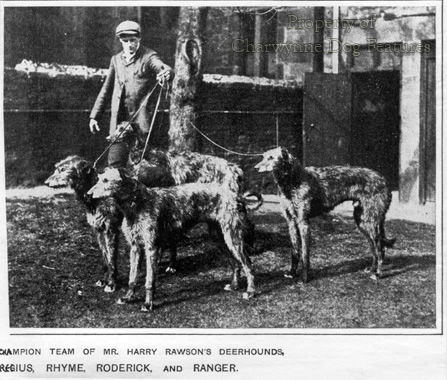400 Value of Deerhound blood
THE VALUE OF DEERHOUND_BLOOD
by David Hancock

 The blood of the Deerhound has long been prized by knowledgeable lurcher men. Many sportsmen are most impressed by their hunting skills and quite remarkable facility for detecting movement over huge distances. They can track as well as hunt by sight. Some breeds have changed in the hands of show breeders but this breed seems to have retained its essential type over several centuries. It is easy to overlook the value of hounds which could hunt red deer successfully before the wide use of long range firearms. In a harsh winter the skill of such a dog could mean the difference between starvation and survival for the primitive hunters. Once this value diminished however, these huge shaggy fast-running hounds fell on hard times, surviving only in some areas through the patronage of the nobility. Pennant recorded, when visiting Scotland in 1769, that he saw at Gordon Castle true Highland greyhounds which had become very scarce. He described these hounds as "of large size, strong, deep-chested, and covered with very long and rough hair", used "in large numbers at the magnificent stag chases by the powerful chieftains." Lurcher men, keepers and stalkers refer to them as staghounds to this day.
The blood of the Deerhound has long been prized by knowledgeable lurcher men. Many sportsmen are most impressed by their hunting skills and quite remarkable facility for detecting movement over huge distances. They can track as well as hunt by sight. Some breeds have changed in the hands of show breeders but this breed seems to have retained its essential type over several centuries. It is easy to overlook the value of hounds which could hunt red deer successfully before the wide use of long range firearms. In a harsh winter the skill of such a dog could mean the difference between starvation and survival for the primitive hunters. Once this value diminished however, these huge shaggy fast-running hounds fell on hard times, surviving only in some areas through the patronage of the nobility. Pennant recorded, when visiting Scotland in 1769, that he saw at Gordon Castle true Highland greyhounds which had become very scarce. He described these hounds as "of large size, strong, deep-chested, and covered with very long and rough hair", used "in large numbers at the magnificent stag chases by the powerful chieftains." Lurcher men, keepers and stalkers refer to them as staghounds to this day.
The Earl de Folcoville had his noted Colonsay strain in the first half of the 19th century. MacNeile, in his chapter on Deerhounds, the first detailed write-up of the breed, in Scrope's book on deerstalking of 1838, described "Buskar", one of the purest specimens, as 28" at the shoulder, with a chest girth of 32", weighing 85lbs, going on to write: "This dog is of pale yellow, and appears to be remarkably pure in his breeding, not only from his shape and colour, but from the strength and wiry elasticity of his hair, which by Highlanders is thought to be a criterion of breeding." MacNeile stated that the grey dogs appeared to be "less lively and did not exhibit such a development of muscle, particularly on the back and loins, and have a tendency to cat hams".
The classic use of Deerhounds involves a brace coursing their quarry and killing it unaided. This demands not just speed, strength and stamina but superbly constructed dogs, whose limbs and, especially, feet can cope with boulder-strewn terrain at great speed, whose joints can withstand fierce jarring and whose physique combines great power with lightness of build. The first point my eye seeks out in a moving Deerhound, even in a show ring, is a noticeable springiness of step and "daisy-clipping" action in the feet; for me all other points are subordinate to this essential feature. It reveals soundness. 
I haven't seen the attractive red coat colouration for many many years but I have seen some fine blue-grey specimens down the years. I get depressed when I see Deerhounds in the show ring with woolly coats, poor feet and no spring in their gait, lacking leg muscle and depth of chest. This breed is descended from a primitive hunting dog, prized for its field prowess, famed for its strength and speed and essentially a functional animal. I get concerned too about Deerhounds being bred for great size at the expense of soundness; for the breed standard to stipulate a minimum height of 30" at the withers for dogs and 28" for bitches, with no mention of soundness first and foremost, is to my mind, unwise.
In a pedigree breed with a closed gene pool a loss of stature becomes increasingly likely with each decade. I would much rather have an overall sound dog of 28" at the withers than an oversized unsound dog. An inch or two in stature can never match the overall soundness so essential in a hunting dog. Deerhound blood has been utilised not just by lurcher men in Britain but by their opposite numbers hunting coyotes in America and kangaroo in Australia. Such breeders are seeking all round hunting skills: a good nose, coursing ability and the keen determination to pursue a fast quarry over some distance. 
The Deerhound is considered to be the brightest of the sighthounds, some say handed down from the collie blood used many years ago. But just as Deerhound blood is of value in outcrosses, so too may , for example, Greyhound blood be needed once again in the Deerhound breed, for the genetic base is small. Pure breeding is fine when things are going well but disastrous when inbred faults such as weak hindquarters are being perpetuated.
It is likely that the Deerhound has retained its essential type because it seems to attract distinguished owners and breeders. Names like Miss Doxford of the Ruritania kennel, the Misses Loughrey of the Ross kennel, Miss Bell of the Enterkine kennels, Miss Linton (Geltsdale), Miss Hartley (Rotherwood) and Miss Noble (Ardkinglas) would grace any breed club register. But I do see, mainly over the last decade, far too many Deerhounds in a new mould: small, woolly-coated and light in bone, with sharp pointed heads and completely lacking the soft eye. Hounds like this are really without true type.
Writing in his "Dogs of Scotland", published in 1891, Thomson Gray remarked that: "Another great drawback in connection with deerhounds is that they become small and weedy through interbreeding...all breeders will acknowledge that it is a serious one". Nobody wants the Deerhound to have the narrow head of the Borzoi or Greyhound but if this pedigree breed does need an infusion of new blood there are some fine Deerhound type lurchers around, although far too many of the latter are rather coarse-headed and often over-boned.
Show ring Deerhounds nowadays can display poor toplines, short upper arms, slab-sided chests and a lack of underline. The Deerhound in the United States has the highest percentage of dilated cardiomyopathy seen in breeds there. These dogs come from British stock. Although hip dysplasia is not a common problem in the breed, osteochondritis, and torsion of the stomach, spleen and lung have been recorded. Lurchermen utilising Deerhound blood would be wise to obtain health checks before investing in breeding material. Stature too in this breed should be based on their hunting feats and never on sheer size alone; this is a fine sporting breed not an ornament.